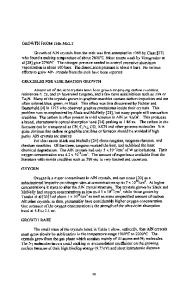Single versus successive pop-in modes in nanoindentation tests of single crystals
- PDF / 488,257 Bytes
- 11 Pages / 584.957 x 782.986 pts Page_size
- 66 Downloads / 227 Views
Yanfei Gao and George M. Pharr Department of Materials Science and Engineering, University of Tennessee, Knoxville, TN 37996; and Materials Science and Technology Division, Oak Ridge National Laboratory, Oak Ridge, TN 37831
Hongbin Bei Materials Science and Technology Division, Oak Ridge National Laboratory, Oak Ridge, TN 37831 (Received 6 October 2015; accepted 25 April 2016)
From recent nanoindentation experiments, two types of pop-in modes have been identified: a single pop-in with a large displacement excursion and a number of pop-ins with comparable and small displacement excursions. Theoretical analyses are developed here to study the roles played by indenter tip radius, pre-existing defect density, heterogeneous nucleation source type, and lattice resistance on the pop-in modes. The evolution of dislocation structures in earlier pop-ins provides input to modeling a stochastic, heterogeneous mechanism that may be responsible for the subsequent pop-ins. It is found that when the first pop-in occurs near theoretical shear stress, the pop-in mode is determined by the lattice resistance and tip radius. When the first pop-in occurs at low shear stress, whether the successive pop-in mode occurs depends on how the heterogeneous dislocation nucleation source density increases as compared to the increase of the total dislocation density. The above transitions are found to correlate well with the ratio of indenter tip radius to the mean spacing of dislocation nucleation sources.
I. INTRODUCTION
Nanoindentation testing has gained considerable popularity as a powerful tool to investigate material properties at small length scales. Many useful material parameters can be obtained from the quantitative information of the indentation load P and indenter displacement h, such as elastic modulus, hardness, flow behavior (e.g., hardening exponent), viscoelasticity, creep, and fracture toughness.1–8 When the indentation depth is several tens of nanometers, many tests on a variety of single crystals exhibit sudden displacement excursions, or “pop-ins”, on the P–h curves.9–14 As shown by the representative examples in Fig. 1, before the first pop-in, the P–h curve is found to be reversible and follows Hertzian contact theory, implying that deformation is purely elastic. Therefore, the maximum stress in the solid upon the first pop-in, denoted as popin stress, can be used to evaluate the elastic–plastic transition and thus the material strength at small scales. Although pop-ins can be caused by fracture of a surface oxide layer in some materials,15,16 for carefully prepared Contributing Editor: Jürgen Eckert a) Address all correspondence to this author. e-mail: [email protected] b) Current address: 3M Company, St. Paul, MN. DOI: 10.1557/jmr.2016.193
and polished single crystals with low dislocation densities, the first pop-in corresponds to a stress at or near the theoretical shear strength of the material, that is, in the range of l/5–l/30 where l is the shear modulus.10,17 The pop-in arises from homogeneous dislocation nucle
Data Loading...









